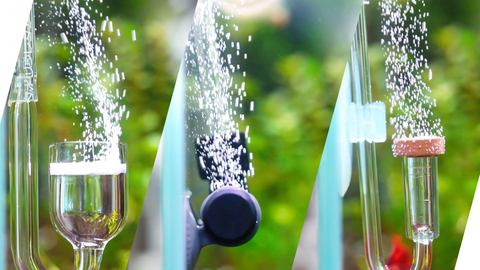The Mysteries of CO2 in a Planted Tank Explained - Nice and Easy
Benefits of CO2 in a Planted Tank
There are two basic requirements for plants to grow through photosynthesis; nutrients and light. The most important nutrient for plant growth is carbon. Since carbon dioxide (CO2) is abundant in the atmosphere, plants simply draw their carbon directly from CO2 in order to photosynthesize and grow. In an aquarium, CO2 levels are naturally very low and without any supplementation, submerged aquatic plants will not be able to grow properly. When CO2 is a limiting factor, plants cannot fully utilize all the available light to photosynthesize. This can allow algae to grow and compete with the plants for nutrients, further stunting plant growth. By introducing CO2 into the aquarium, plants can achieve healthy growth faster and therefore outcompete algae.

When plants receive CO2, they produce oxygen as a byproduct of photosynthesis. Once the water column receives high saturation of oxygen, plants become pearling, or releasing O2 bubbles. It’s a good indication of healthy growth!
The introduction of carbon into an aquarium is typically achieved by using a pressurized gas tank controlled by a regulator, solenoid and needle valve. Pressurized CO2 is the best way to go for the more advanced hobbyists or for those keeping larger aquariums, 20 gallons or above. This type of CO2 injection can be dangerous for beginners, not only for the fact that you’re dealing with pressurized gas but also because turning the gas too high and releasing too much CO2 can kill your livestock very quickly. However, it is the most cost effective way to introducing CO2 for your plants. You will need the following:
- CO2 Tank - Tanks come in many different shapes and sizes. The larger the tank the more CO2 it will contain, which will determine how often you need to refill it.
- Drop Checker - This handy aquarium tool will help measure the concentration of CO2 in you aquarium. Although not 100% accurate, it will give you a good idea of how much CO2 is in your water and prevent from gassing your fish.
- CO2 Regulator - A regulator is necessary to inject and maintain the flow of CO2 in your tank. The more advanced setups will include a solenoid, which can be set to turn on and off with a timer.
- CO2 tubing - Special CO2 airline tubing is needed. Note that CO2 tubing is different than regular airline tubing as it won't leach CO2.
- Diffuser - A diffuser will be the final part of the setup. It is usually made of a porous material that will equally disperse the CO2 gas into the water.
Tell us - Was this article helpful? Please leave a comment below!
If you have any questions regarding this article, please DM us on Instagram, Facebook, or email support@buceplant.com so we can assist you - @buceplant





Leave a comment